Product managers and project managers often aim for the same finish line. However, beneath these shared goals are distinct mechanisms and tensions that can make or break a company.
One is focused on the why and what, while the other is concerned with the how and when. These differences can be a crucial factor in choosing the career that best fits your skills.
If you’re a curious career switcher or a new graduate, you’ve come to the right place! Here’s everything you need to know about product managers and project managers.
What Does a Product Manager Do?
A product manager is responsible for the entire product lifecycle, from ideation to development, launch, and updates. They focus on understanding why and what to build, and help teams connect their daily work to business goals.
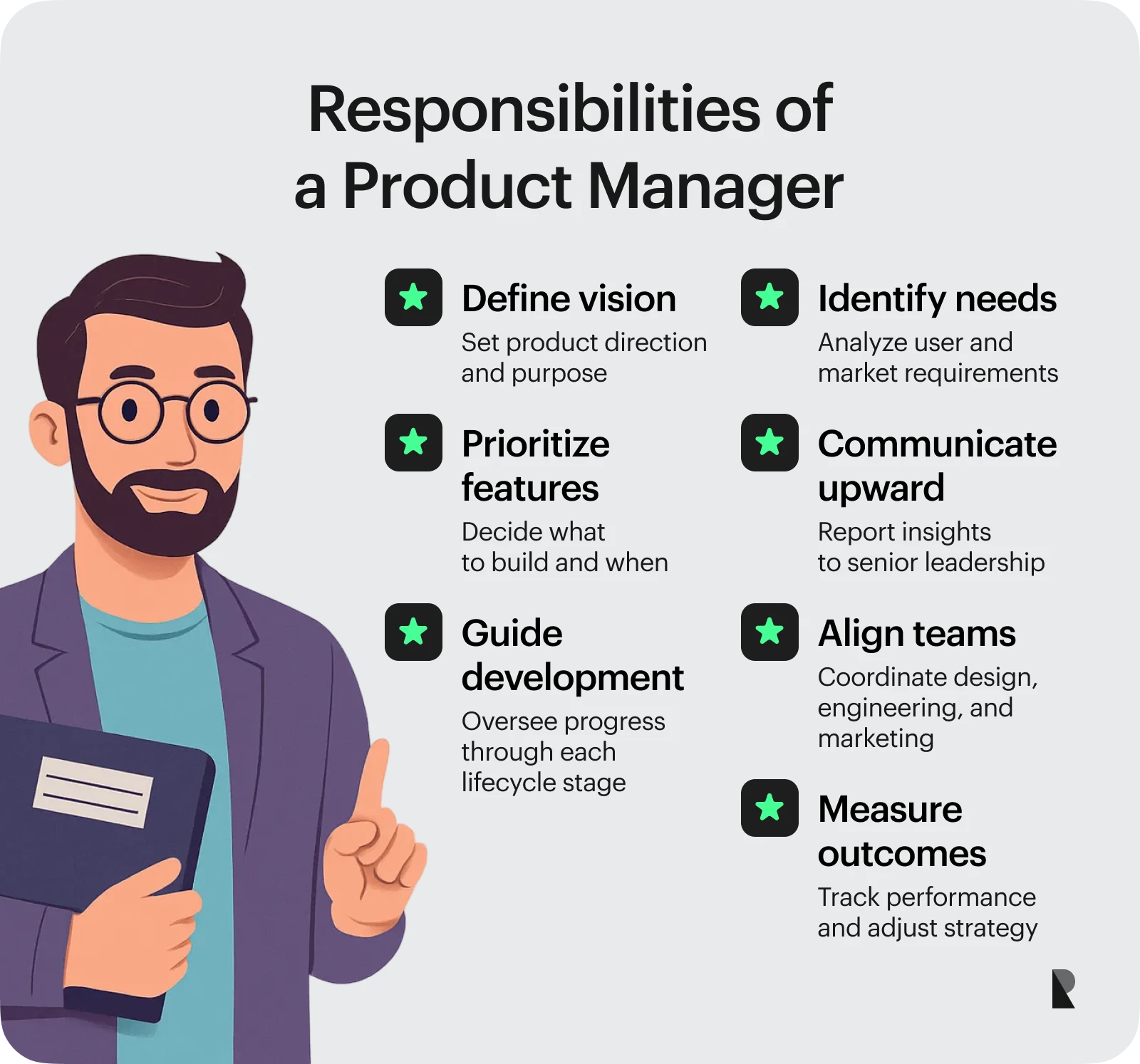
Product managers play a crucial role because they make long-term decisions that significantly impact overall success. They report directly to senior leaders like the Chief Product Officer, Chief Executive Officer, and Chief Operations Officer.
What Does a Project Manager Do?
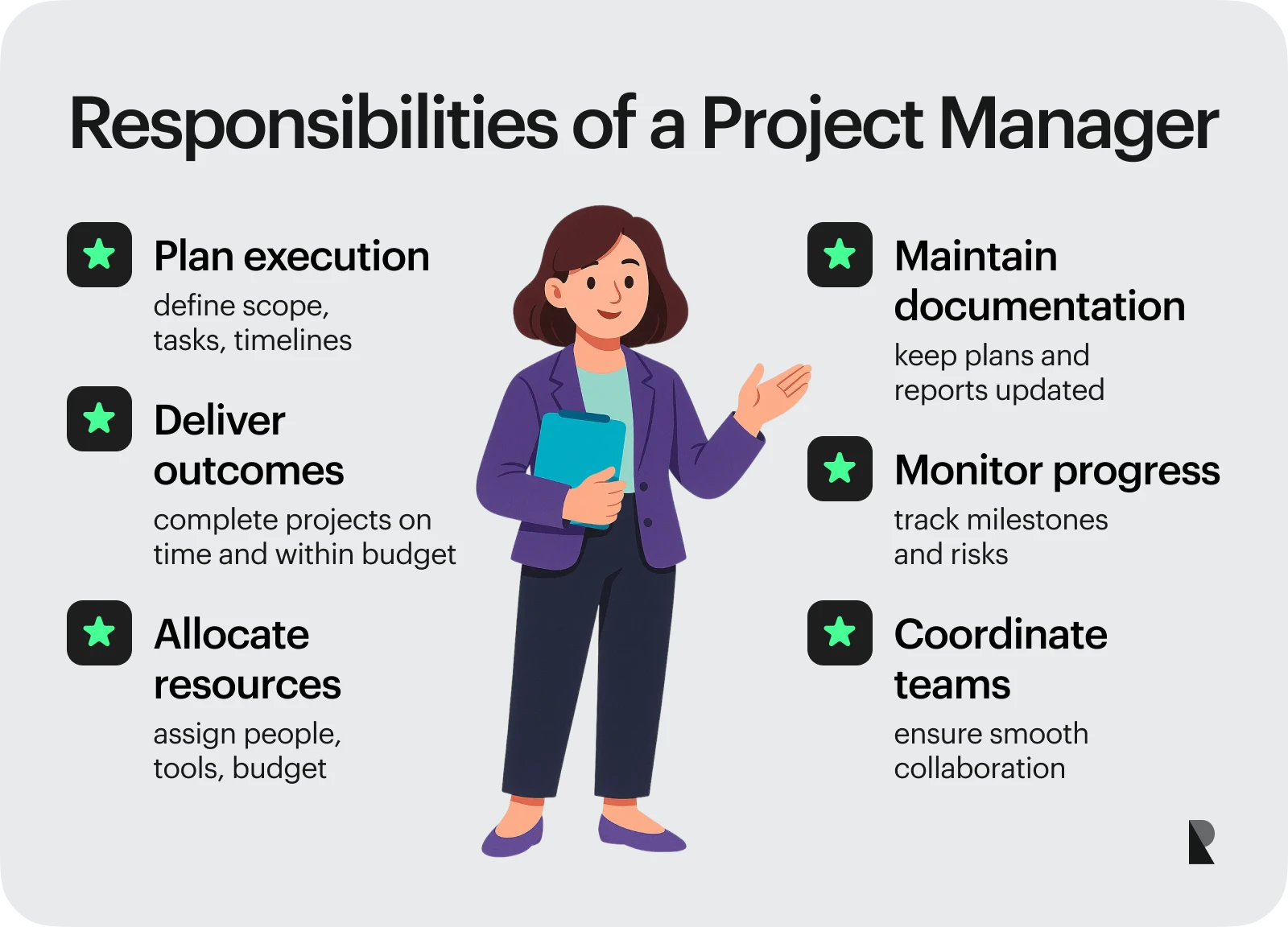
A project manager focuses on how and when tasks are completed. They implement processes to complete a specific project, including planning, assigning tasks, and managing resources within deadlines and budgets. Successful execution and completion of projects are their top priority.
Key Differences Between Product Managers and Project Managers
| Key aspects | Product managers | Project managers |
|---|---|---|
| Role and core mission | Focused on what and why of a product | Focused on how and when of a project |
| Responsibilities |
|
|
| Metrics and KPIs |
|
|
| Decision-making approach | Decides on what product to create and why. | Decides on how and when to complete tasks. |
| Scope and timeline | The work scope is broad, and the product lifecycle defines the timeline. | The work scope is narrow with a clear start and end. |
| Leadership and influence | Indirect | Direct |
| Tools and methodologies |
|
|
Role definition and core mission
Product managers strive to develop products that meet market demands. Their success is measured by whether customers like the product, whether it makes users happy, and whether it generates enough profit for the company. That’s why companies prefer to hire an experienced digital product design firm to do the work.
Project managers work to deliver results within the set budget, timeline, and project scope. They build teams, solve problems, and are evaluated based on what they deliver.
Key responsibilities
Product managers conduct market research and synthesize data to create product roadmaps, prioritizing features in demand. They utilize product strategy, business insight, and user empathy to inform their long-term product direction.
Product manager responsibilities include:
- Managing the product lifecycle from ideation to execution
- Allocating budget and resources
- Managing product launches
- Defining product features
Project managers turn plans and product visions into actionable tasks, manage schedules and resources, and ensure projects are completed efficiently. They also monitor risks and address problems that arise during the project.
Project manager responsibilities include:
- Setting project targets
- Managing cross-functional teams and delegating tasks
- Communicating project needs and progress with executives and other stakeholders
- Maintaining quality standards when delivering results
Metrics and KPIs
Success metrics differ for product and project managers. But both must consider customer satisfaction, process quality, employee engagement, and financial performance in their key performance indicators.
Product managers set KPIs based on long-term goals. They prioritize the product’s health and how well it meets customer needs. Their KPIs may include measuring the following:
- Quarterly sales: Is the product profitable?
- Customer engagement: How interested are the people in the product? How long do they use it?
- User adoption: How many people are actually using the products?
- Customer satisfaction: Are the customers happy with the product?
Project managers base their KPIs on the clear end-goals of a project. They focus on metrics that measure execution. For example, a project manager's KPIs can include the following:
- Cost performance index: Comparison between the budgeted cost and the actual project cost.
- Return on investment: Measures actual value earned per dollar spent.
- Planned value: Evaluates the value that a project is expected to generate within a specific period.
- Project errors: Tracks the number of times a team committed errors during the project development and implementation phase.
- Schedule performance index: A metric used to estimate if a project will be completed behind, ahead, or right on schedule.
Decision-making approach
A product manager decides what the product should be and why it matters. When choosing features to add, they consider the challenges the product addresses, customer expectations, and potential for growth.
In comparison, a project manager determines how and when the work to build the product is completed. Their decisions focus on who should work on specific tasks, how long each task should take, and how to track progress and mitigate risks.
Scope and timeline
A product manager has a broad perspective that covers the overall vision, strategy, and user needs. Every action should align with business goals and current market feedback. The work continues as long as the product is active and evolving.
A project manager has a narrow scope with clear start and end dates. Projects are temporary and conclude when specific outputs are delivered within budget, time, and other constraints.
Collaboration and communication style
Product managers collaborate with various stakeholders, including customers, designers, marketers, and engineers. They clearly communicate the product vision, ensuring all contributors align and strategize. Their communication is strategic and persuasive, driving collective focus on product goals.
Project managers organize internal teams to accomplish milestones on time and within budget. This requires clear and frequent communication between cross-functional teams regarding schedules and responsibilities, ensuring everyone is aware of their next steps. Their communication is practical and focused on keeping the project on track.
Leadership and influence
Product managers rely on how well different teams collaborate to align efforts toward product success. While they are visionaries and strategists in defining products, their leadership is indirect, as there is no single central team under their command.
Project managers lead with a direct approach, assigning tasks and setting expectations for operational efficiency. They focus on tracking progress and maintaining momentum throughout the project lifecycle.

Tools and methodologies
Product managers use tools to understand customer needs, design features, and monitor product growth and success over time. These include:
- ProductPlan for mapping and communicating product goals and timeline,
- SurveyMonkey and Google Analytics for data gathering and tracking interactions with customers, and
- Jira for seamless collaboration between product development teams and other cross-functional teams.
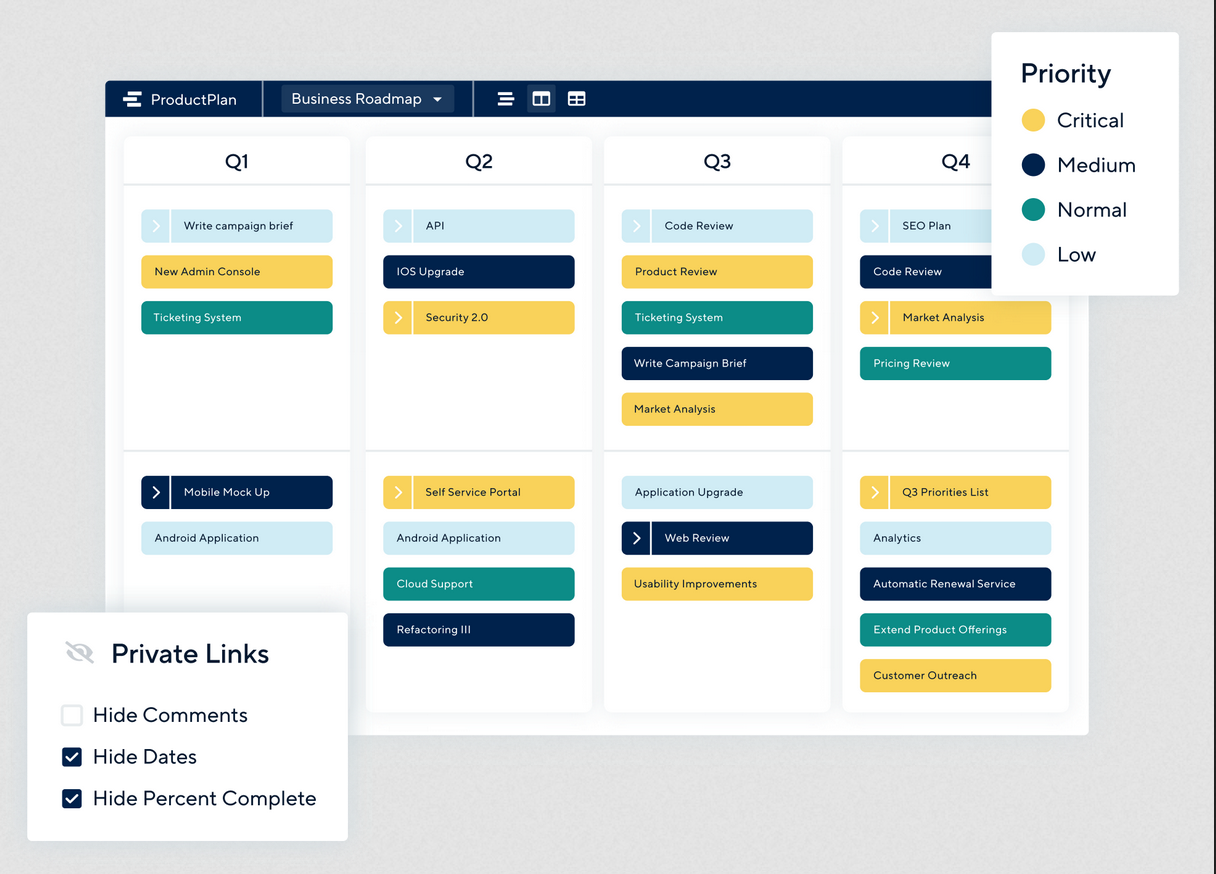
Roadmap dashboard via ProductPlan

Marketing insights dashboard via Google Analytics
Project managers utilize tools to keep everyone on schedule and track task progress, ensuring project completion. These include:
- Smartsheet for creating timelines and visualizing task developments,
- Trello to manage workflow and monitor task status,
- Risk management tools to identify and mitigate potential problems, and
- Project calendars to organize tasks and deadlines.
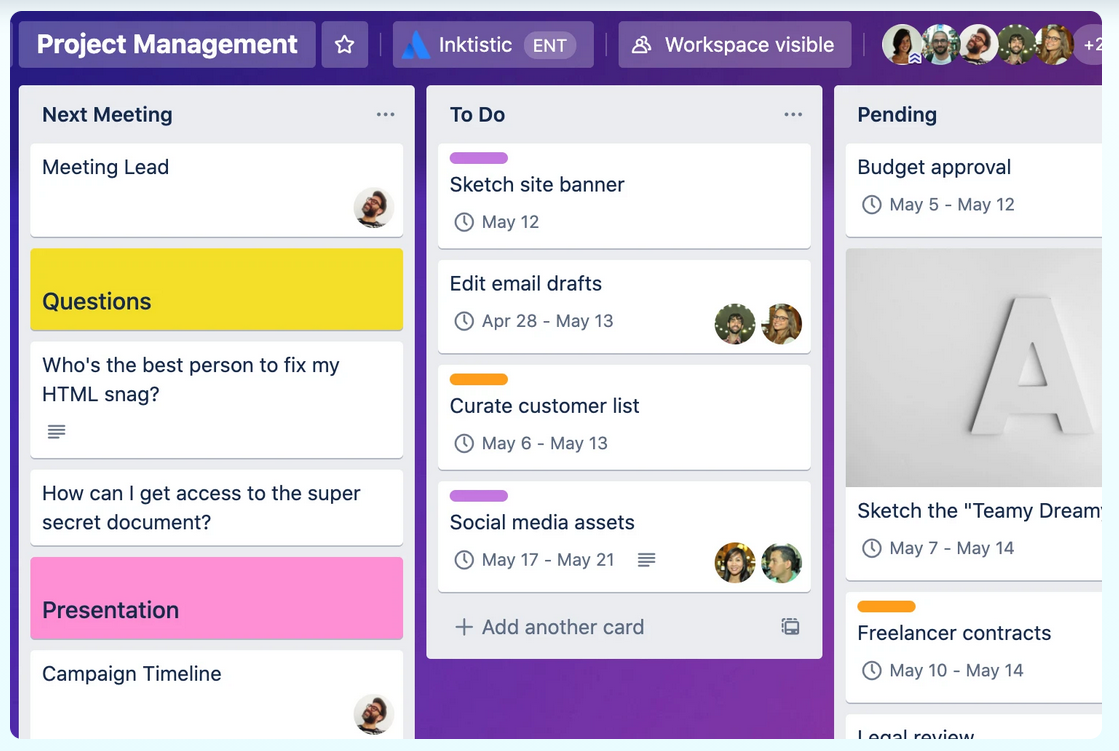
Team management dashboard via Trello

Project calendar template via Notion
Both distinct roles use similar management methodologies, such as Agile, Scrum, and Waterfall, but their choice depends on the scope and limitations of the product or project.
How Product Managers and Project Managers Work Together
Despite the differences in roles, product and project managers can form a strategic alliance to build and deliver something valuable.

Overlapping responsibilities and shared goals
Working toward aligned goals enables product managers and project managers to collaborate and support each other. They can identify risks and implement strategies to address them before they become serious problems. Resources are allocated more effectively when both managers have input on prioritizing project and product objectives.
With two sets of eyes, it is easier to maintain the quality of deliverables. Product and project managers must stay aligned in planning, communication, and setting priorities to ensure effective management.
Collaborations across the product development lifecycle
The project manager is a key figure in the product development lifecycle, overseeing the process of building the product. With guidance from the product manager, who decides what the product should be, understands customer needs, and identifies key features, the project manager can keep everything on track and solve problems that may slow development.
Collaboration between product and project managers is a delicate balancing act of strategy and execution that enables success.
Balancing vision (PM) with execution (PjM)
When the product manager sets achievable visions within a meaningful timeframe, the project team stays motivated and focused on tangible outcomes. This realism enables the project manager to translate the vision into actionable plans, schedules, and resource allocations, leading to more effective execution.
When a product manager is customer-centric, their vision emphasizes solving user problems and creating a meaningful impact, thereby raising the bar for quality and relevance. This balanced approach to setting and executing visions ensures sustainable success and continuous innovation.
How to Become a Product Manager
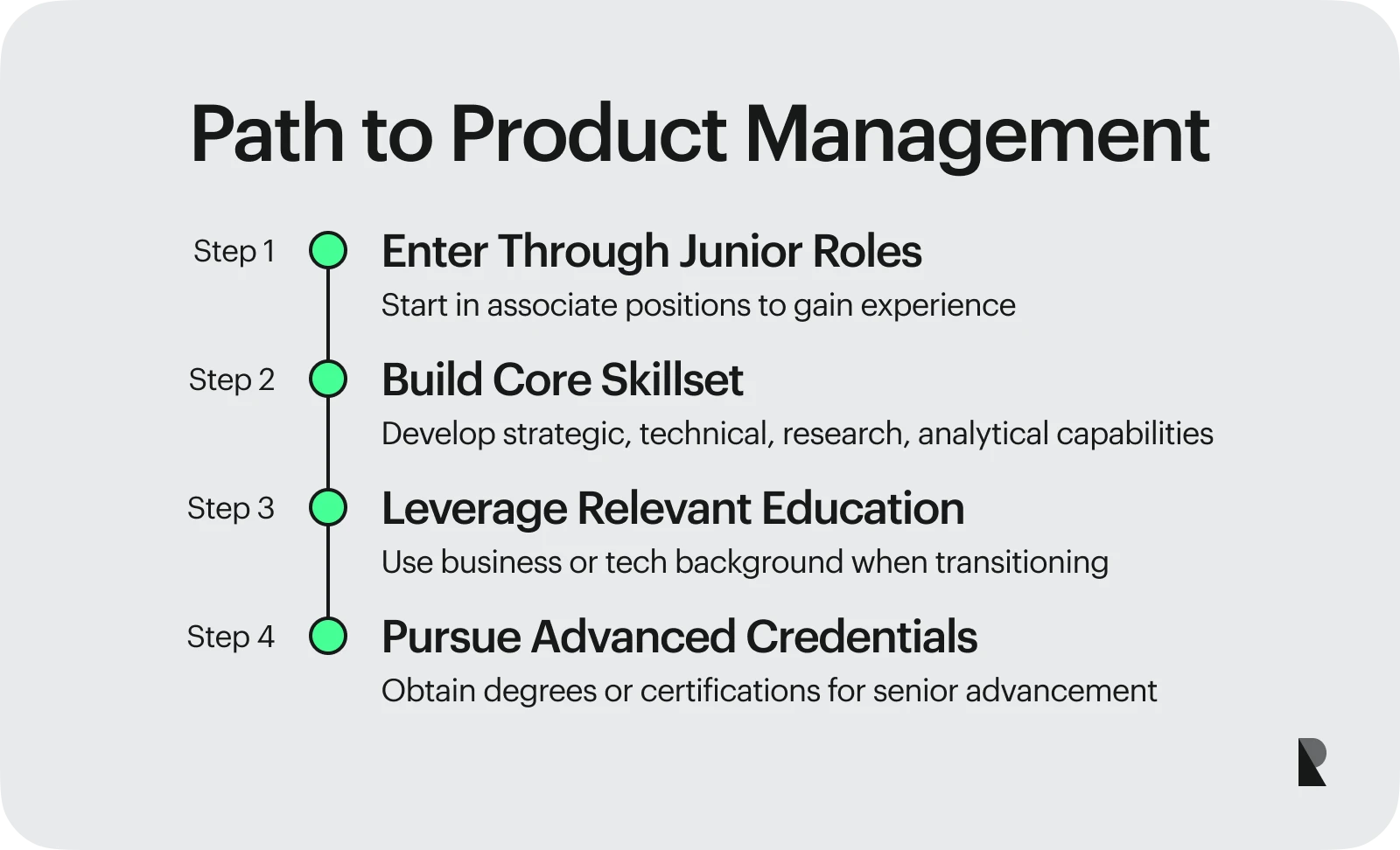
Aspiring product management professionals can seek roles as junior or associate product managers. From there, you can move up to product manager, senior product manager, Product Director, VP of Product, and Chief Product Officer.
Since products are a core factor in business success, product managers are expected to have a balanced set of hard and soft skills. These include:
- Strategic Thinking
- Technical Expertise
- Research Skills
- Advanced Analytics
A college degree is not required for a career in product management, but it can be beneficial. Anyone with a relevant degree in business, software development, or marketing can transition to product management. As you move to senior roles, such as VP of Product, some companies may require advanced degrees and certifications.
Essential certifications
Certifications help aspiring product managers develop the necessary skills and demonstrate their ability to achieve results. They provide a clearly defined path to learning product management, leading to higher pay or promotion. Must-have certificates for product managers include:
- Agile Certified Product Manager
- Product Marketing Certification
- Scrum Product Owner Certification
- Lean Product Management Certification
- Certified Product Manager
Career forecast
The increasing complexity and digitization of products have driven demand for product managers. Organizations require professionals who can effectively bridge the technical, business, and customer perspectives to deliver value efficiently.
According to job search platform Zippia, there are over 23,000 product managers in the United States. The average salary is $126,399 with additional bonuses, but it can reach over $220,000 a year. With the growing product management market, projected to reach $81.01 billion over the next 10 years, especially in the tech sector, becoming a product manager presents a promising future.

Product lifecycle management market size projection via Precendence Research
How to Become a Project Manager

Project managers often deal with constraints that challenge the delivery of results. The clock is constantly ticking, the budget is too little, and the team is stretched thin. If anything goes wrong, the project manager is held accountable for the outcome.
The barrier to entry is high for those seeking to enter the project management field. Besides significant industry knowledge, you need grit, decisiveness, and proactiveness as a project-oriented leader. You must also be an effective facilitator, especially when working with multiple teams.
Among the most valuable skills to have are the following:
- Communication
- Problem-Solving
- Risk Management
- Negotiation
Those interested in project management can start as a project coordinator or associate project manager. These roles involve administrative tasks and organizing logistics, making them ideal for learning the ropes.
As you climb your way up the ladder, you can become a project manager, director of project management, and eventually a Chief Operating Officer (COO).
Essential certifications
To be a successful project manager, you need to embrace lifelong learning. This includes earning certificates to grow your skills and expand your knowledge. Here are some certifications that help establish trust with employers.
- Project Management Professional Certificate
- Certified Scrum Master
- PMI Risk Management Professional
- Master Project Manager
- PMI Agile Certified Practitioner
Career outlook
The Bureau of Labor Statistics projects a 6% increase in project management-related job openings over the next decade. This translates to over 78,000 job openings annually in the United States, which is faster than the average annual job growth in the industry.
The demand for project managers is high in various sectors, including manufacturing, construction, IT, finance, insurance, and professional services. A project manager earns an average annual salary of $94,987, with some roles paying up to $149,000 in high-paying cities in the United States.

Project management job growth across five continents. Image via PMI
Why project management skills strengthen both roles
Honing project management skills enables product and project managers to lead and motivate teams more effectively, allocate resources strategically, and deliver quality results. It helps them coordinate teams, manage project timelines, and ensure product releases align with strategic objectives.
Project Manager vs. Product Manager: Making the Right Choice
Choosing between becoming a project manager or a product manager heavily relies on the skills you have, what you enjoy doing, and your working style.
If you are deeply interested in understanding how customers’ minds work, collaborating with diverse people, and creating new things that bring value to end-users, then becoming a product manager might be the right calling. Product managers are all about creating big-picture visions and solving real problems with innovative products. They helm the thinktank behind every product lifecycle.
On the other hand, if you are a doer who likes to organize, plan, and ensure tasks are completed on time, being a project manager can be a good fit. They possess strong leadership skills and can pivot and adjust strategies in response to changes in project scope, team dynamics, or external conditions.
Whatever your decision, it is essential to approach it with curiosity, critical thinking, and a commitment to lifelong learning. These traits collectively enable product managers and project managers to guide their teams successfully and even exceed expectations.
Nov 11, 2025
